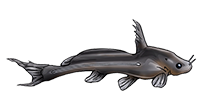Betancur, R, A Acero & LM MejÃa-Ladino, 2004. Análisis filogenético preliminar de algunos bagres marinos (Siluriformes: Ariidae) neotropicales [A preliminary phylogenetic analysis of some neotropical marine catfishes (Siluriformes: Ariidae)]. Memoria de la Fundación La Salle de Ciencias Naturales 62 (158): 61-85. [Journal dated 2002].
English Abstract
A preliminary phylogenetic analysis was carried out for some sea catfishes from Colombia and adjacent tropical waters. A total of 19 species was examined:16 of the ingroup (Ariidae) and three of the outgroup (Auchenipteridae, Doradidae and Heptapteridae). 45 morphological characters, mainly osteological, were used to run the parsimony analysis in PAUP 3.1. The phylogenetic relationships among different taxa were resolved in a strict consensus cladogram computed from eight equally parsimonious trees (tree length=59 steps), with a total of 11 clades. Examined species of the genera Ariopsis, Bagre and Cathorops are included in three monophyletic groups. Selenaspis dowii, S. herzbergii and Arius proops form an unresolved monophyletic group. The species of the genus Arius form a polyphyletic group. Arius cookei, A. kessleri and S. troschelii are closely related, forming the sister group of the species of the genus Cathoroops. A. platypogon is more closely related to the genus Bagre. A. proops, on the other hand, is more closely related to the genus Selenaspis. The species of the genera Ariopsis, Bagre and Selenaspis, plus Arius platypogon and A. proops, are included in a monophyletic group. Galeichthys ater from South Africa is the most basal taxon of the Ariidae species studied.
Phylogeny of neotropical ariids
- Silurus
- Posts: 12450
- Joined: 31 Dec 2002, 11:35
- I've donated: $12.00!
- My articles: 55
- My images: 896
- My catfish: 1
- My cats species list: 90 (i:1, k:0)
- Spotted: 428
- Location 1: Singapore
- Location 2: Moderator Emeritus





